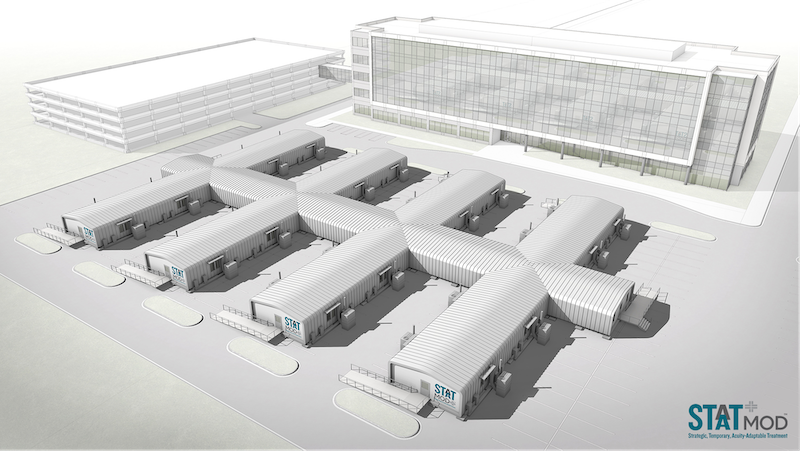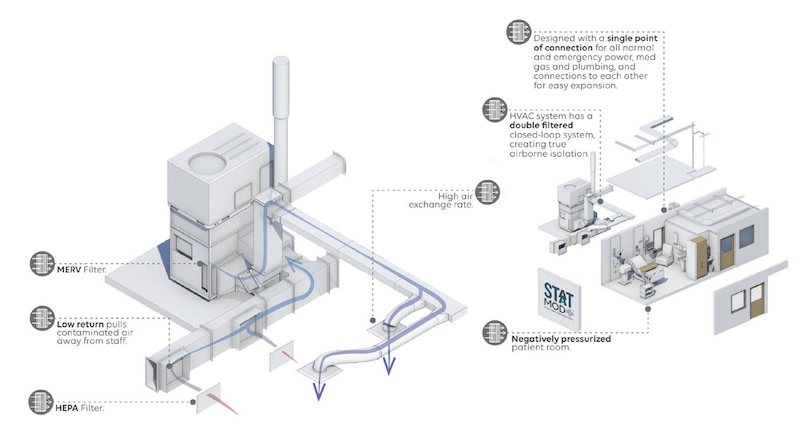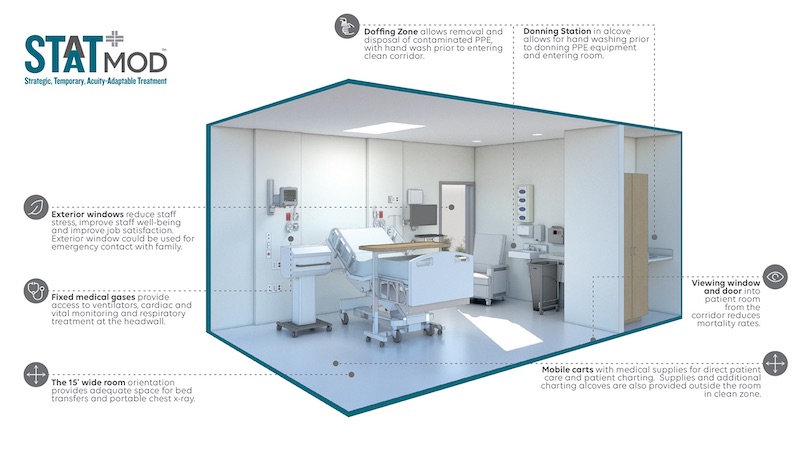In its prefabrication factory in Appleton, Wis., The Boldt Company, a national general contractor, is manufacturing modules for STAAT Mod, a prefab modular solution designed by HGA for assembling field hospitals capable of providing airborne infection isolation rooms.
STAAT is an acronym for Strategic Temporary Acuity-Adaptable Treatment. The isolation rooms are designed with enough clearance for safe bed transfers, and can accommodate equipment and a reclining chair. The system, which is expandable, includes flexible support spaces, three-bay negative pressure units, an intake module, equipment room and staff work area, clean utility and medication/nourishment spaces, staff lounges and private work areas, and the electrical/mechanical infrastructure needed for operations.
Boldt currently has seven modules in various stages of production for an unnamed customer on the East Coast. (It declined to make public that customer’s name because the contract hadn’t been finalized at presstime.)
The building team on this project includes the mechanical contractor Tweet/Garot, the electrical engineer Faith Technologies, and the medical equipment planning firm IMEG. Information about STAAT Mod, and an animated video of how this system comes together, can be viewed and downloaded here.
Kurt Spiering, a healthcare market sector leader for HGA, notes that modularization has been A factor in the healthcare arena for the past six to eight years, partly because of the industry’s construction labor shortages. “It’s been in our blood for a while.” The challenge in developing STAAT Mod, he explains, was “maintaining the quality of care using different materials, and building something within three weeks.”
Boldt started exploring prefabrication for a 274-bed acute care hospital it built—in partnership with Herrero Builders— a few years ago for Sutter Health in San Francisco. The hospital sits on a one-block lot that had virtually no drop-off area available for materials. For that project, Boldt put up a temporary factory on Treasure Island, where it produced components like water closets and drinking fountain stations.
It then had a client in Chicago, Advocate Aurora Health, for which it produced a proof-of-concept modular master plan for healthcare clinics, medical office buildings, and ambulatory facilities. “We built the prototype in our Appleton factory, and drove it around the country” to test its durability, says Dave Kievet, Boldt’s COO.

STAAT Mod is designed and engineered to be expandable to meet the community's needs.
Then, he says, “the coronavirus hit.” Boldt began contacting some of its long-standing design and building partners to figure out how to develop a modular system with negative pressurization. In that endeavor, Boldt consulted with Theda Care and Froedtert Hospital in Wisconsin.
The Boldt Company is one of the industry’s leading proponents of Integrated Lean Project Delivery to control costs, increase the speed of construction, and drive out waste. Kievet says that ILPD allowed the building team to design and develop STAAT Mod “very quickly.”
Spiering says that choices were made around two priorities: staff and patient safety, and getting good clinical outcomes. Jeff Harris, HGA’s director of engineering, adds that the building team took a “kit of parts” approach, which included choosing to use a standard 3- to 4-ton rooftop air handling unit that could service a couple of rooms that are designed with oversized ducts. The rooms that are negative pressurized draw air through HEPA filters.
Now that the U.S. Army Corps of Engineers is supervising the conversion of spaces like convention centers to alternate patient care facilities, HGA and Boldt views the states, which are coordinating these conversion efforts, as the primary buyers for STAAT Mod. Since it made public information about STAAT Mod, Boldt has had conversations with at least 20 potential customers, says Stacy Robben, the firm’s Vice President of Business Development.
Kievet estimates that once an order is placed, Boldt can get the first module up and operational within 14 to 17 days, and complete an entire order within 20 to 28 days. “The target is to get the completion down to 14 days,” he says. The price of the system will vary by the number of modules used. HGA|Boldt’s pricing sheet states that a two-room airborne isolation room would cost $335,000. A three-bed open bay negative pressure modular $317,000. So a two-tier system with 32 isolation rooms and all the other bells and whistles would run about $8.3 million.

This illustration shows the system's air handling and filtration mechanics.
Boldt sees three different practical applications for STAAT Mod: as supplemental interior isolation rooms within an existing system of care; as a modular system that’s connected to an existing hospital’s infrastructure, built (theoretically) on that facility’s parking lot; and as a self-sufficient temporary hospital with infrastructure.
STAAT Mod could be used to treat a hospital’s most severe cases, freeing up hospital and clinic beds for procedures like elective surgeries, which is where many healthcare systems derive a substantial portion of their revenues. Kievet says it’s conceivable that modules could be disassembled and reassembled as needed, or built on foundations for more permanent use.
Boldt has formed alliances with several other prefabrication firms in different parts of the country, including Southland Industries, to expand its capacity to provide STAAT Mod systems across the U.S. Boldt has 14 offices in the U.S., and healthcare is one of nine industry sectors it serves.
Related Stories
Augmented Reality | Jan 27, 2023
Enhancing our M.O.O.D. through augmented reality therapy rooms
Perkins Eastman’s M.O.O.D. Space aims to make mental healthcare more accessible—and mental health more achievable.
K-12 Schools | Nov 30, 2022
School districts are prioritizing federal funds for air filtration, HVAC upgrades
U.S. school districts are widely planning to use funds from last year’s American Rescue Plan (ARP) to upgrade or improve air filtration and heating/cooling systems, according to a report from the Center for Green Schools at the U.S. Green Building Council. The report, “School Facilities Funding in the Pandemic,” says air filtration and HVAC upgrades are the top facility improvement choice for the 5,004 school districts included in the analysis.
Giants 400 | Nov 14, 2022
4 emerging trends from BD+C's 2022 Giants 400 Report
Regenerative design, cognitive health, and jobsite robotics highlight the top trends from the 519 design and construction firms that participated in BD+C's 2022 Giants 400 Report.
Healthcare Facilities | Jun 20, 2022
Is telehealth finally mainstream?
After more than a century of development, telehealth has become a standard alternative for many types of care.
Coronavirus | May 20, 2022
Center for Green Schools says U.S. schools need more support to fight COVID-19
The Center for Green Schools at the U.S. Green Building Council released a new report detailing how school districts around the country have managed air quality within their buildings during the second year of the COVID-19 pandemic.
Industry Research | Mar 9, 2022
Survey reveals five ways COVID-19 changed Americans’ impressions of public restrooms and facilities
Upon entering the third year of the pandemic, Americans are not only more sensitive to germs in public restrooms, they now hold higher standards for the cleanliness, condition and technology used in these shared spaces, according to the annual Healthy Handwashing Survey™ from Bradley Corporation conducted in January.
Codes and Standards | Feb 21, 2022
New standard for ultraviolet germicidal irradiation
The Illuminating Engineering Society (IES) recently introduced the standard, ANSI/IES RP-44-21 Recommended Practice: Ultraviolet Germicidal Irradiation.
Coronavirus | Jan 20, 2022
Advances and challenges in improving indoor air quality in commercial buildings
Michael Dreidger, CEO of IAQ tech startup Airsset speaks with BD+C's John Caulfield about how building owners and property managers can improve their buildings' air quality.
Coronavirus | Jul 20, 2021
5 leadership lessons for a post-pandemic world from Shawmut CEO Les Hiscoe
Les Hiscoe, PE, CEO of Shawmut, a $1.5 billion construction management company headquartered in Boston, offers a 5-point plan for dealing with the Covid pandemic.
Resiliency | Jul 15, 2021
A new report urges federal investment in healthier buildings
The National Institute of Building Sciences also calls for code changes and greater cooperation between building owners and the AEC community.

















